An Innovative Simulation Agent-Based Model for the Combined Sea-Road Transport as a DSS
Abstract
1. Introduction
2. Problem Overview
3. Methods
3.1. Definition of Policies
- Port management: this macro-category includes all the policies inherent to the port and its surroundings, to ensure its development in terms of operations and services that are carried out within it (speed and efficiency of execution);
- Economic incentives: this category captures all the economic value policies in terms of contributions and incentives for developing combined transport, such as the Marebonus and the Ecobonus experiences. Therefore, all those policies provide economic support through subsidies for transport operators;
- Network and services design: finally, this last category entails policies on network, services and vehicle features to improve the performance of some specific transport elements, such as modifications of characteristics on vehicles (speed increase, frequency or different vehicle fleet) or infrastructure (number of lane or platform conditions) and establishment of new services.
3.2. Methodology Proposed for the Innovative Simulation Tool
- Geographical constraint: it considers the geographical position of origin and destination of the trip concerning alternative transport modes. It permits to remove specific O/D pairs whose trips are necessarily carried out by road-only such as interzonal trips between some regions;
- minimum trip length: considering the specifications and suggestions in [28], an O/D pair can be potentially shifted from road-only transport to the combined sea-road transport if the trip length, computed as the shortest path between origin and destination on the road network, is higher than the threshold value of 300 km representing the minimum value for the convenience of combined transport;
- accessibility criteria: it considers the geographical position of origin and destination of the trip concerning the seaports’ location. The match between seaports and hinterland region has been done according to the shortest path, as well as considering existing Ro-Ro services. The O/D pair is selected if the minimum length of the road-only trip is larger than the sum of the access and egress distance to/from the starting/ending port considering the current/new Ro-Ro services.
4. Results and Discussion
4.1. Case Study
4.2. The Effects of the Policies and Their Impacts
5. Conclusions
Author Contributions
Funding
Conflicts of Interest
References
- Sjödin, Å.; Henningsson, E.; Flodström, E. Documentation of a Calculation Tool for Maritime Emissions, SUTRANET Deliverables; Annex 1.3.2 to Sutranet Final Report; IVL, Swedish Environmental Research Institute: Aalborg, Sweden; Gothenburg, Sweden, 2007. [Google Scholar]
- Novo-Corti, I.; Gonzalez-Laxe, F. Maritime transport and trade: The impact of European transport policy. An overview of maritime freight transport patterns. Eur. Res. Stud. 2009, 12, 131–147. [Google Scholar]
- Perakis, A.N.; Denisis, A. A survey of short sea shipping and its prospects in the USA. Marit. Policy Manag. 2008, 35, 591–614. [Google Scholar] [CrossRef]
- Suárez-Alemán, A.; Trujillo, L.; Medda, F. Short sea shipping as intermodal competitor: A theoretical analysis of European transport policies. Marit. Policy Manag. 2015, 42, 317–334. [Google Scholar] [CrossRef]
- Marrero Del Rosario, A.; Casajust, P.G.; Tunon, P.S. Short sea shipping: An analysis of European promotion programmes from 2005 to 2019. In Proceedings of the 2021 World of Shipping Portugal. An International Research Conference on Maritime Affairs, Portugal, 28–29 January 2021. Online Conference. [Google Scholar]
- Pastori, E.; Brambilla, M.; Maffii, S.; Vergnani, R.; Gualandi, E.; Skinner, I. Research for TRAN Committee—Modal Shift in European Transport: A Way Forward; European Parliament, Policy Department for Structural and Cohesion Policies: Belgium, Brussels, 2018. [Google Scholar]
- Raza, Z.; Svanberg, M.; Wiegmans, B. Modal shift from road haulage to short sea shipping: A systematic literature review and research directions. Transp. Rev. 2020, 40, 382–406. [Google Scholar] [CrossRef]
- Marzano, V.; Papola, A.; Simonelli, F. A methodology for evaluating the competitiveness of Ro-Ro services. In Transport Infrastructure and Systems; Dell’Acqua, G., Wegman, F., Eds.; Talylor & Francis Group: London, UK, 2017; ISBN 978-1-138-03009-1. [Google Scholar]
- Sambracos, E.; Maniati, M. Competitiveness between short sea shipping and road freight transport in mainland port connections; the case of two Greek ports. Marit. Policy Manag. 2012, 39, 321–337. [Google Scholar] [CrossRef]
- Comi, A.; Polimeni, A. Assessing the potential of short sea shipping and the benefits in terms of external costs: Application to the Mediterranean Basin. Sustainability 2020, 12, 5383. [Google Scholar] [CrossRef]
- Hjelle, H.M. The double load factor problem of Ro-Ro shipping. Marit. Policy Manag. 2011, 38, 235–249. [Google Scholar] [CrossRef]
- Paixão, A.C.; Marlow, P.B. The competitiveness of short sea shipping in multimodal logistics supply chains: Service attributes. Marit. Policy Manag. 2005, 32, 363–382. [Google Scholar] [CrossRef]
- Tavasszy, L. Freight modelling for the next big logistics innovations. In Proceedings of the Keynote Lecture in 15th World Conference on Transportation Research, Mumbai, India, 26–31 May 2019. [Google Scholar]
- Tavasszy, L.; de Bok, M.; Alimoradi, Z.; Jafar, R. Logistics decisions in descriptive freight transportation models: A review. J. Supply Chain Manag. Sci. 2019, 1, 1–13. [Google Scholar]
- Marzano, V.; Papola, A. Modeling freight demand at a national level: Theoretical developments and application to Italian demand. In Proceedings of the European Transport Conference, Strasbourg, France, 4–6 October 2004. [Google Scholar]
- Chen, T.M.; Rudzikaite, L.; Van Leest, E.; Tardieu, P.; Bröcker, J.; Schneekloth, N.; Korzhenevych, A.; Szimba, E.; Kraft, M.; Krail, M.; et al. Deliverable 3: Report on Model Specification and Calibration Results TRANS-TOOLS (TOOLS for Transport Forecasting and Scenario Testing). Deliverable3; TNO Inro: Delft, The Netherlands, 2005. [Google Scholar]
- Baindur, D.; Viegas, J.M. An agent based model concept for assessing modal share in inter-regional freight transport markets. J. Transp. Geogr. 2011, 19, 1093–1105. [Google Scholar] [CrossRef]
- Lupi, M.; Farina, A.; Orsi, D.; Pratelli, A. The capability of motorways of the sea of being competitive against road transport. The case of the Italian mainland and Sicily. J. Transp. Geogr. 2017, 58, 9–21. [Google Scholar] [CrossRef][Green Version]
- Tavasszy, L.; Smeenk, B.; Ruijgrokc, C.J. A DSS for modelling logistic chains in freight transport policy analysis. Int. Trans. Oper. Res. 2006, 5, 447–459. [Google Scholar] [CrossRef]
- Holmgren, J.; Davidsson, P.; Persson, J.; Ramstedt, L. TAPAS: A multi-agent-based model for simulation of transport chains. Simul. Model. Pract. Theory 2012, 23, 1–18. [Google Scholar] [CrossRef]
- Golfarelli, M.; Rizzi, S.; Proli, A. Designing what-if analysis: Towards a methodology. In Proceedings of the ACM Ninth International Workshop on Data Warehousing and OLAP, ACM, Arlington, VA, USA, 3–10 October 2006. [Google Scholar]
- Carrese, S.; Nigro, M.; Petrelli, M.; Renna, A. Identifying policies for intermodal logistics chains based on domestic Ro-Ro services. In Maritime Supply Chains; Elsevier: Amsterdam, The Netherlands, 2020. [Google Scholar]
- Contship Italia Group and RSM. Corridoi ed Efficienza Logistica dei Territory—Edizione 2020. 2020. Available online: https://www.srm-maritimeconomy.com (accessed on 23 May 2020).
- Baindur, D.; Viegas, J. Challenges to implementing motorways of the sea concept—Lessons from the past. Marit. Policy Manag. 2011, 38, 673–690. [Google Scholar] [CrossRef]
- Freight Leaders Council. Quaderno 27. Intermodalità Ferroviaria: Nn’occasione per Crescere; Freight Leaders Council: Rome, Italy, 2018. [Google Scholar]
- Ministero delle Infrastrutture e dei Trasporti. Politiche per il Rilancio del Trasporto Ferroviario delle Merci. Intermodalità, Collegamenti tra Interporti, Porti e Piattaforme Logistiche; Ministero delle Infrastrutture e dei Trasporti: Rome, Italy, 2016. [Google Scholar]
- Confcommercio, Imprese per L’Italia. Riflessioni sul Sistema dei Trasporti in Italia; Ufficio Studi Confcommercio—Isfort: Rome, Italy, 2018. [Google Scholar]
- White Paper. Libro Bianco sui Trasporti: Tabella di Marcia Verso uno Spazio Unico Europeo dei Trasporti—Per una Politica dei Trasporti Competitiva e Sostenibile; Commissione Europea: Bruxelles, Belgium, 2011; ISBN 978-92-79-18273-0. [Google Scholar] [CrossRef]
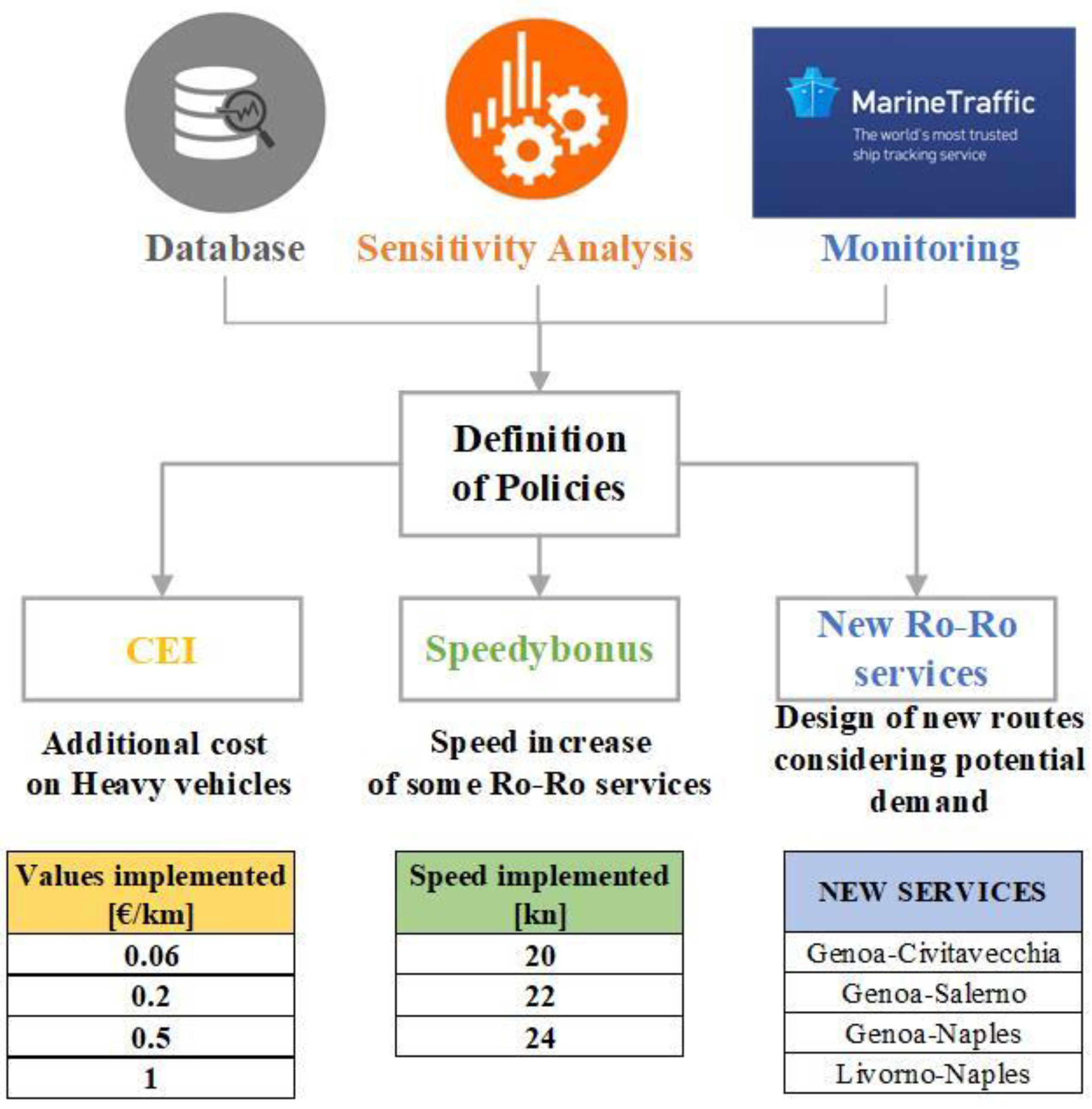
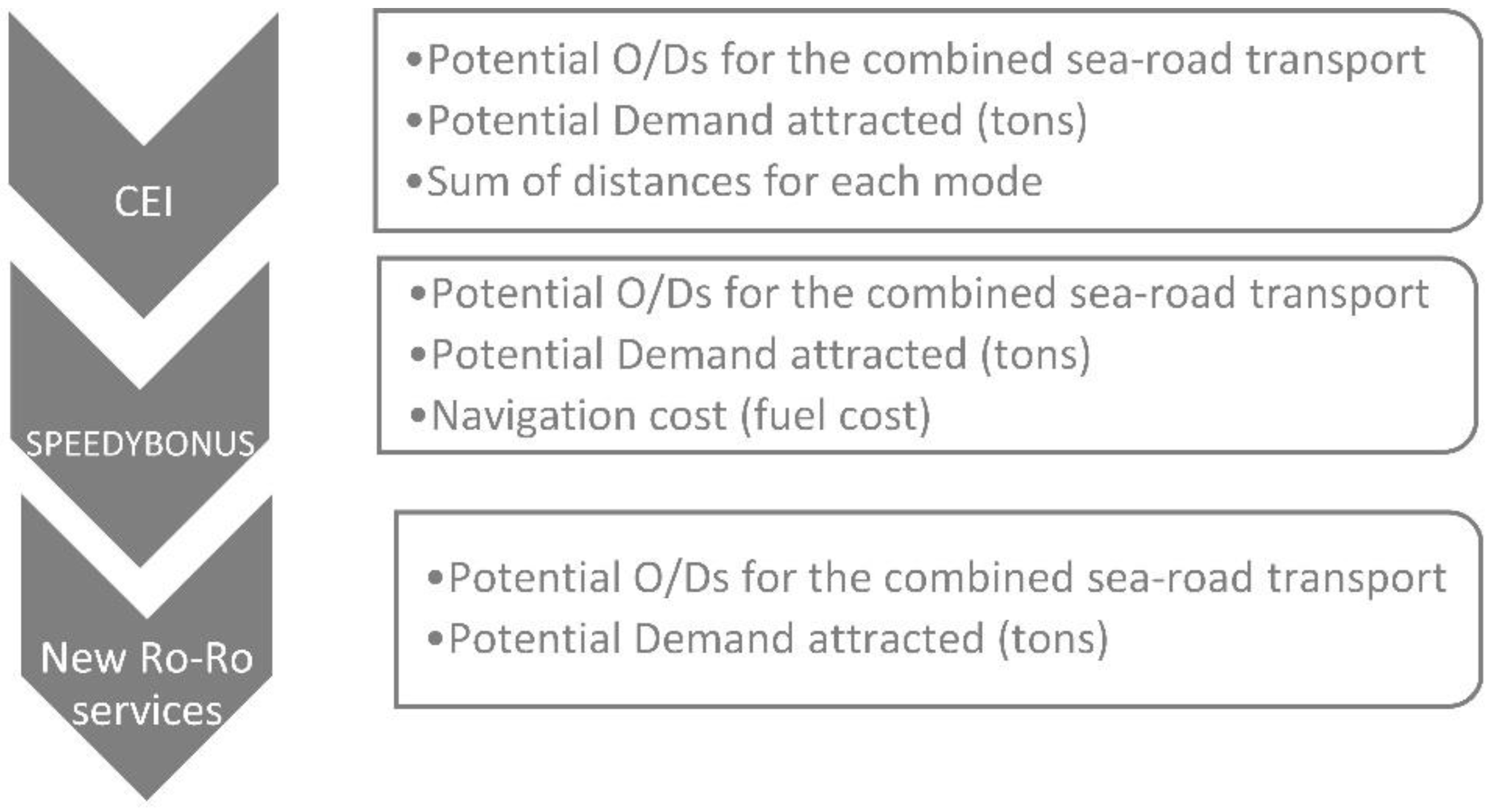
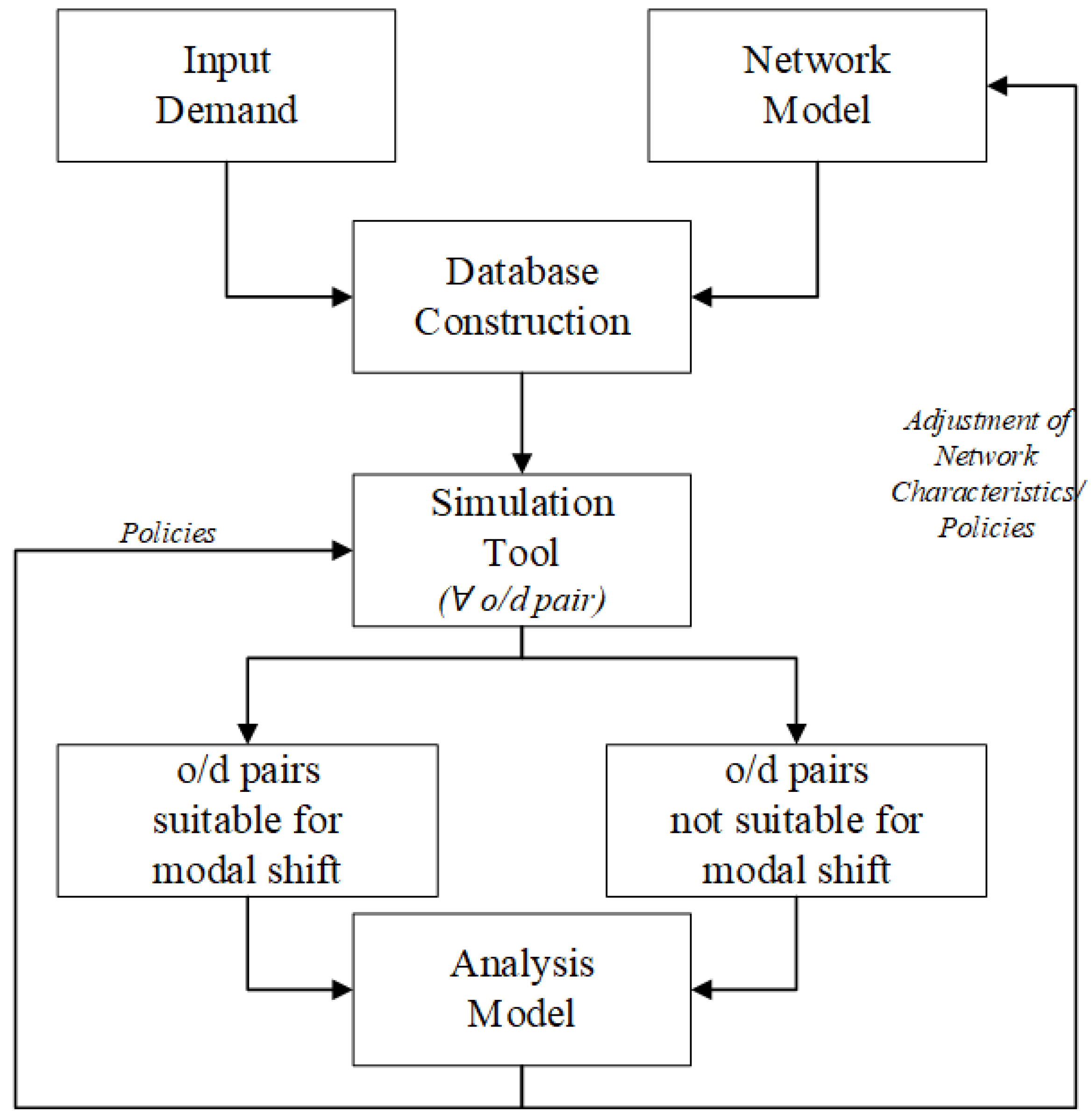
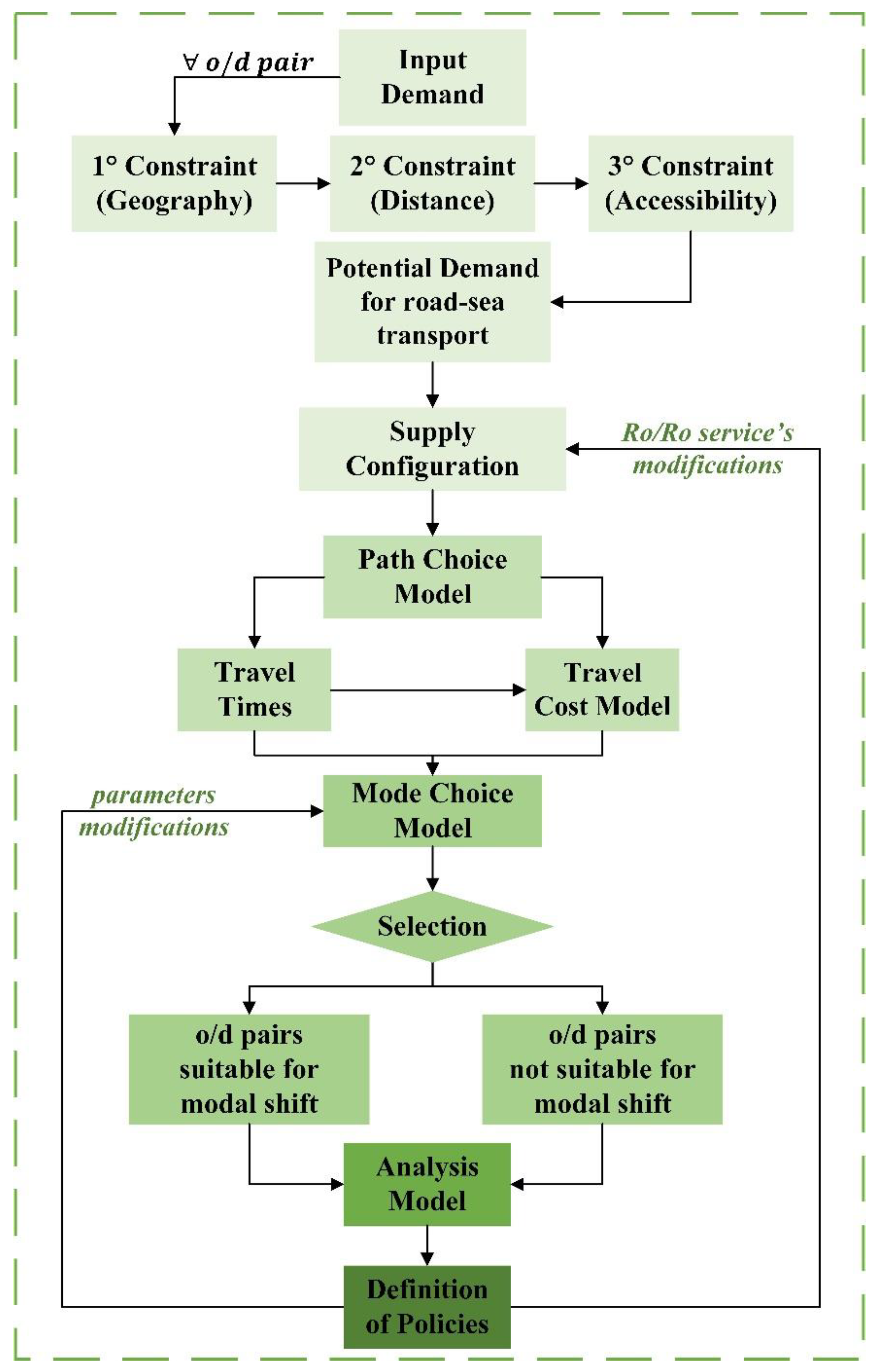
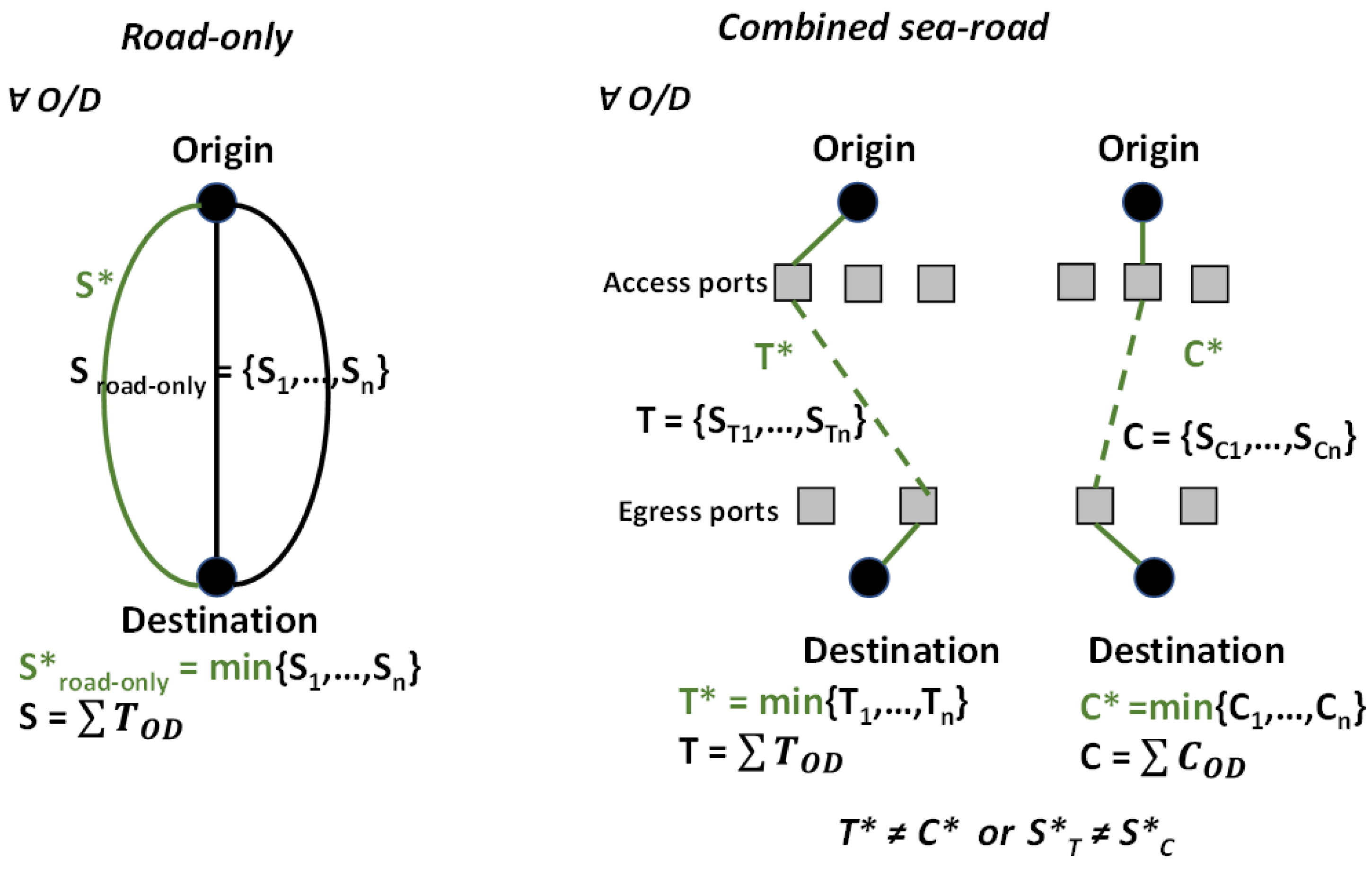
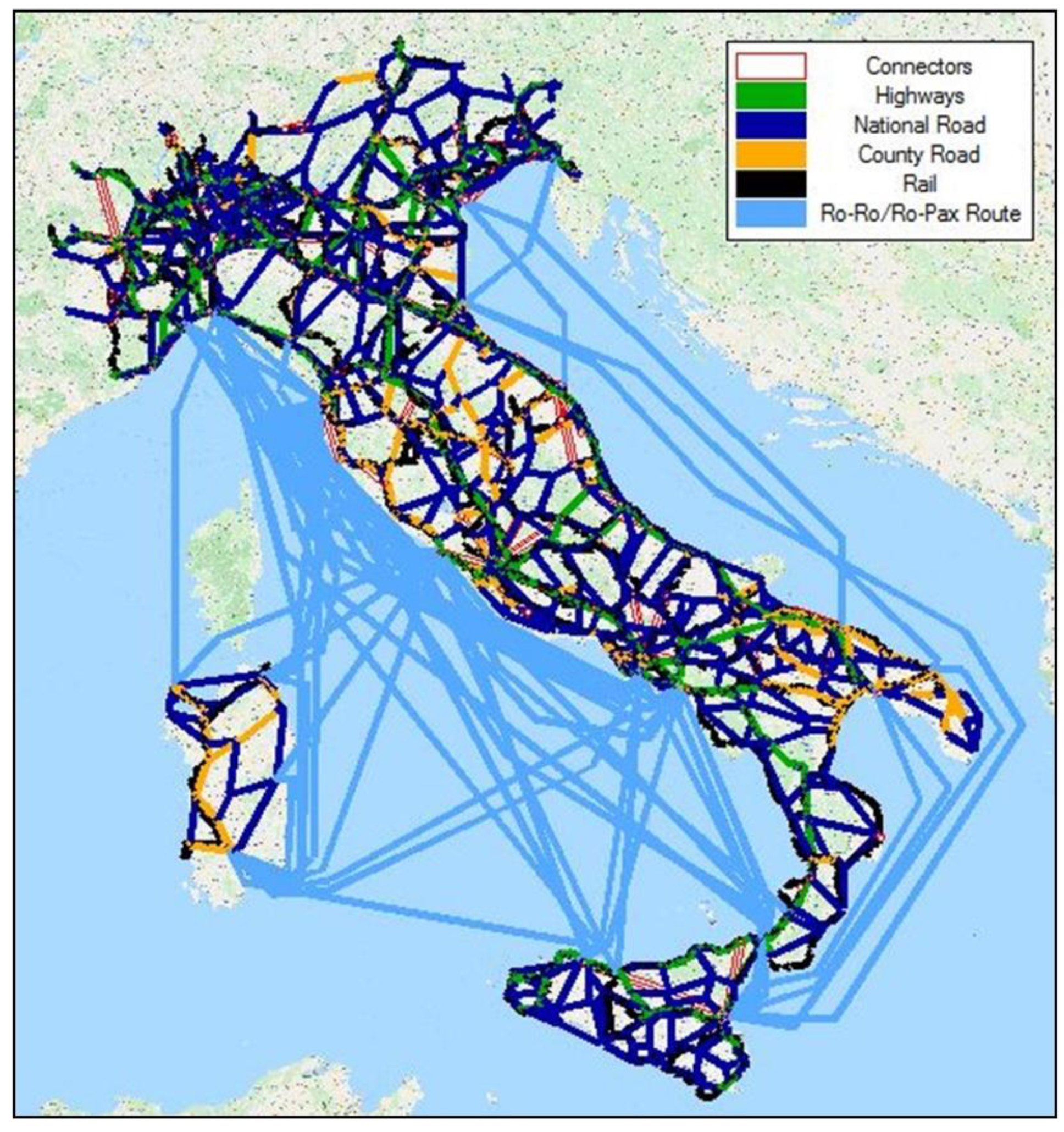
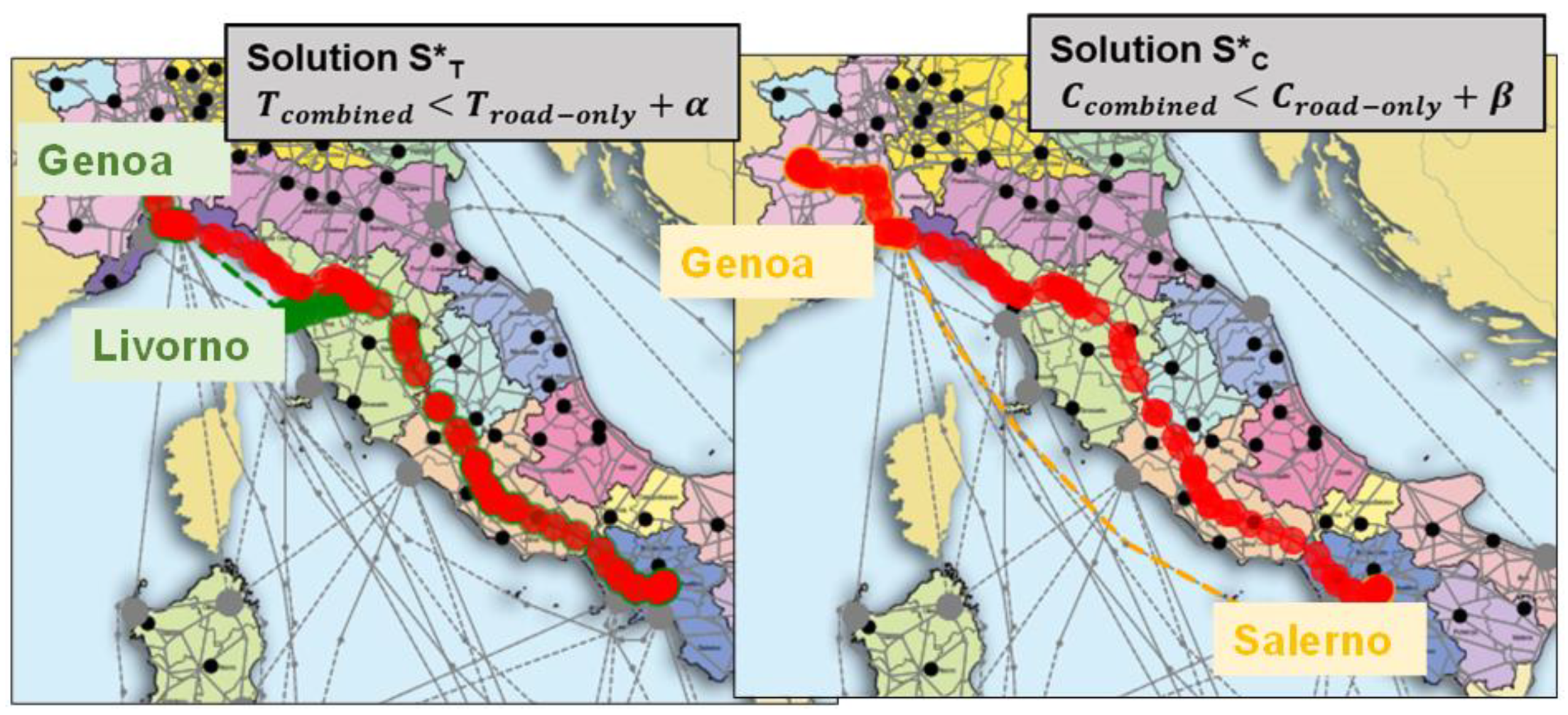
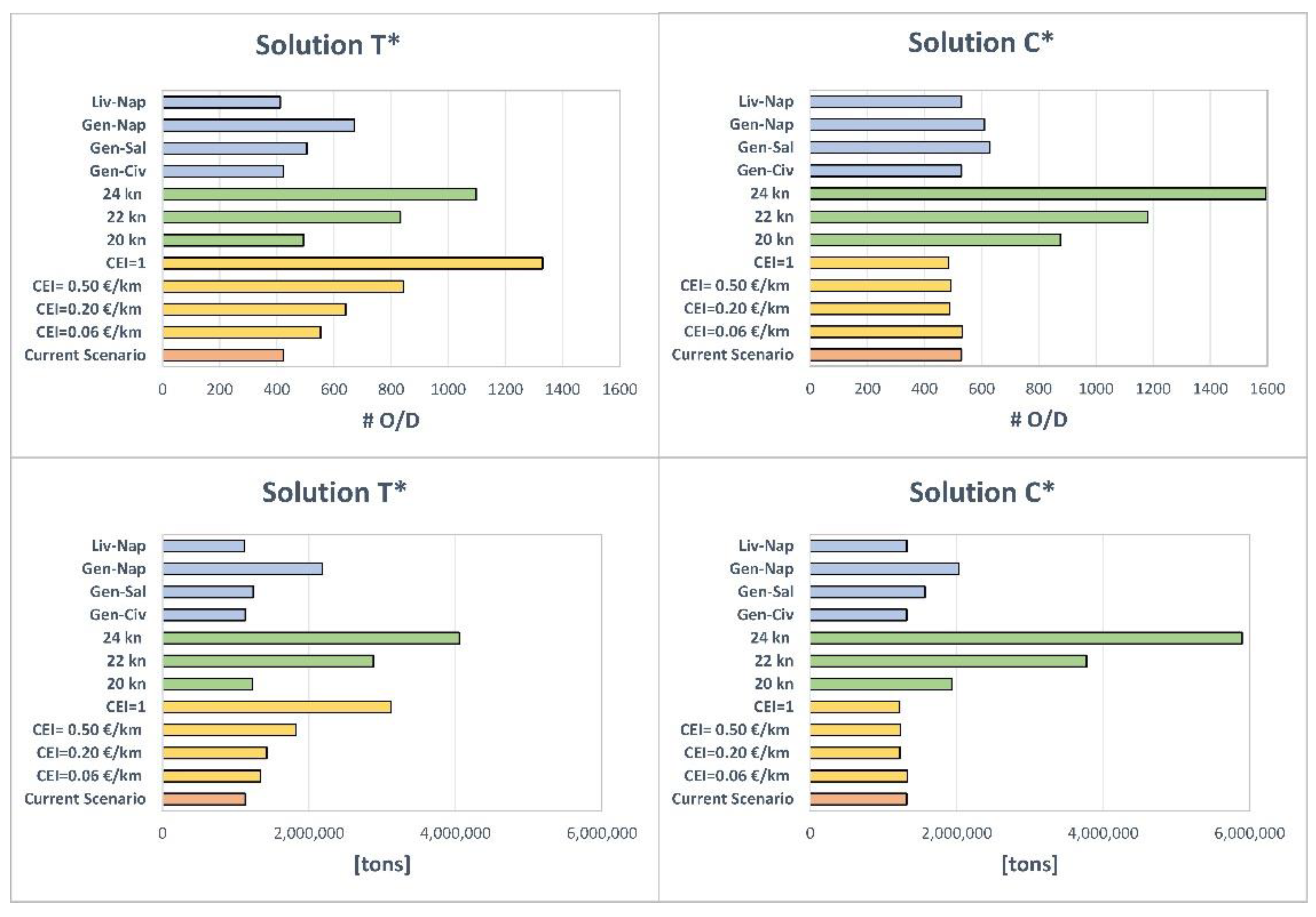
| Solution T* | Solution C* | |||||||
|---|---|---|---|---|---|---|---|---|
| Scenario | Total Distance Road-Only (Km) | Total Distance Sea-Road (Km) | Access + Egress Distance (Km) | Maritime Distance (Km) | Total Distance of Road-Only (Km) | Total Distance Sea-Road (Km) | Access + Egress Distance (Km) | Maritime Distance (Km) |
| Current scenario | 2,243,953 | 409,963 | 269,822 | 140,141 | 2,508,004 | 547,728 | 211,368 | 336,360 |
| CEI = 0.06 €/Km | 2,145,171 | 536,852 | 353,391 | 183,461 | 2,629,848 | 548,960 | 211,905 | 337,055 |
| Δ (%) | −4.40 | 30.95 | 30.97 | 30.91 | 4.86 | 0.22 | 0.25 | 0.21 |
| CEI = 0.20 €/Km | 1,994,351 | 622,330 | 407,181 | 215,149 | 2,859,262 | 516,140 | 194,650 | 321,490 |
| Δ (%) | −11.12 | 51.80 | 50.91 | 53.52 | 14.01 | −5.77 | −7.91 | −4.42 |
| CEI = 0.50 €/Km | 1,665,126 | 849,559 | 534,224 | 315,335 | 2,974,062 | 516,352 | 195,757 | 320,595 |
| Δ (%) | −25.79 | 107.23 | 97.99 | 125.01 | 18.58 | −5.73 | −7.39 | −4.69 |
| CEI = 1 €/Km | 1,229,213 | 1,337,711 | 851,246 | 486,465 | 2,980,370 | 506,161 | 188,993 | 317,169 |
| Δ (%) | −45.22 | 226.30 | 215.48 | 247.12 | 18.83 | −7.59 | −10.59 | −5.71 |
| Solution T* | Solution C* | |||||
|---|---|---|---|---|---|---|
| Scenario Speedybonus | Additional Cost [€] | # O/D Pairs | Additional Demand [tons] | Additional Cost [€] | # O/D Pairs | Additional Demand [tons] |
| 20 kn | 5,769,251 | 70 | 98,169 | 14,333,189 | 346 | 612,560 |
| 22 kn | 31,892,670 | 409 | 1,749,393 | 48,588,214 | 651 | 2,454,455 |
| 24 kn | 69,008,277 | 674 | 2,923,491 | 123,766,910 | 1064 | 4,578,435 |
| Ecobonus | Marebonus | |||||||
|---|---|---|---|---|---|---|---|---|
| Period | 2007–2010 | 2016 | 2017 | 2018 | 2019 | 2020 | 2021 | 2022–2026 |
| Value [Mln €] | 240 | 45.4 | 44.1 | 48.9 | 30 | 20 | 25 | 19.5 |
| Source | AdsP Northern Tyrrhenian Sea | MIT | Stability law 2021 | |||||
Publisher’s Note: MDPI stays neutral with regard to jurisdictional claims in published maps and institutional affiliations. |
© 2021 by the authors. Licensee MDPI, Basel, Switzerland. This article is an open access article distributed under the terms and conditions of the Creative Commons Attribution (CC BY) license (https://creativecommons.org/licenses/by/4.0/).
Share and Cite
Renna, A.; Petrelli, M.; Carrese, S.; Bertocci, R. An Innovative Simulation Agent-Based Model for the Combined Sea-Road Transport as a DSS. Sustainability 2021, 13, 10773. https://doi.org/10.3390/su131910773
Renna A, Petrelli M, Carrese S, Bertocci R. An Innovative Simulation Agent-Based Model for the Combined Sea-Road Transport as a DSS. Sustainability. 2021; 13(19):10773. https://doi.org/10.3390/su131910773
Chicago/Turabian StyleRenna, Alessandra, Marco Petrelli, Stefano Carrese, and Riccardo Bertocci. 2021. "An Innovative Simulation Agent-Based Model for the Combined Sea-Road Transport as a DSS" Sustainability 13, no. 19: 10773. https://doi.org/10.3390/su131910773
APA StyleRenna, A., Petrelli, M., Carrese, S., & Bertocci, R. (2021). An Innovative Simulation Agent-Based Model for the Combined Sea-Road Transport as a DSS. Sustainability, 13(19), 10773. https://doi.org/10.3390/su131910773







